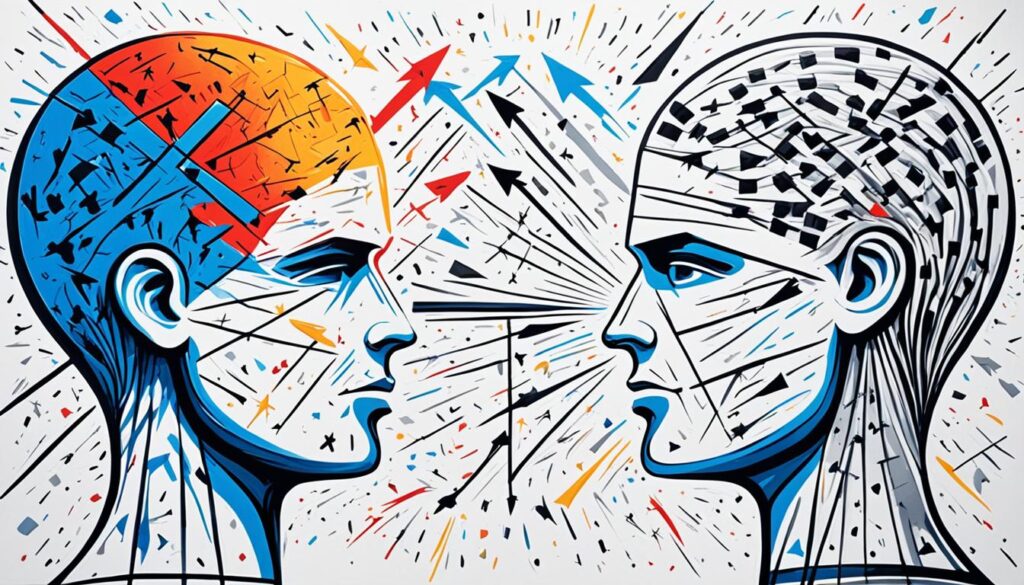Autism and Empathy: Understanding the Connection

About 1 in 44 kids in the US are identified with Autism Spectrum Disorder (ASD). This fact starts important talks about autism and empathy. Despite common beliefs, studies show empathy exists in autism. People with autism often feel others’ emotions deeply, even if they find it hard to grasp someone’s thoughts.
Exploring the link between autism and empathy helps us see past stereotypes. Autistic individuals may react strongly to people’s emotions. Recognizing these varied experiences helps us better understand and support the autistic community, respecting their feelings and experiences.
Debunking Myths: The Real Link Between Autism and Emotional Intelligence
Current research has changed what we think about autism and emotional intelligence. It shows that individuals with autism experience and express emotions in complex ways. Understanding this deeply enriches autism awareness and helps us grasp the emotional challenges people on the spectrum face.
The Stereotype of Empathy Absence in Autism
It’s key to know that not all individuals with autism lack empathy. This old belief has been proven wrong by new studies. These show that people with autism have a wide range of emotional experiences.
Modern Research Shifting the Narrative
Recent studies have revolutionized our understanding. They link the difficulty some with autism have in showing empathy to recognizing emotions in others. This insight stresses the importance of social skills development.
It opens doors to teaching empathy to those with autism. This helps them to connect deeper in emotional interactions.
Diverse Emotional Responsiveness Across the Spectrum
People across the autism spectrum show a wide emotional range. Realizing this expands our view of their emotional intelligence. Gaining self-awareness allows autistic individuals to empathize better. This leads to more effective connections with others.
| Aspect of Emotional Intelligence | Impact on Autism | Potential for Teaching Empathy |
|---|---|---|
| Self-awareness | Difficulty recognizing personal emotions | Interventions to enhance emotional vocabulary and recognition |
| Self-regulation | Challenges in managing responses to emotional stimuli | Strategies to identify triggers and develop coping mechanisms |
| Motivation | Varied interests that influence emotional engagement | Individualized activities to spark connection and understanding |
| Empathy | Differences in experiencing and expressing concern for others | Structured learning environments for recognizing and responding to emotions |
| Social Skills | Social interpreting and interaction variances | Direct instruction and practice in social scenarios |
Autism Awareness: The Spectrum and Social Skills
Understanding the link between autism and social skills reveals a complex challenge. Individuals on the autism spectrum often face difficulties in developing empathy. This is crucial for social interactions. They might struggle with following social cues or understanding non-verbal signals.
Creating supportive environments is key to enhancing empathy in individuals with autism. These spaces allow for the practice of empathy and understanding of social cues. Specialized programs can help bridge the empathy gap for those on the spectrum.
| Social Skill Area | Challenges for Individuals with Autism | Targeted Interventions |
|---|---|---|
| Facial Expression Recognition | Difficulty in interpreting and responding to emotional cues | Therapy sessions focusing on emotion cards and facial mimicry |
| Conversation Skills | Challenges in turn-taking and topic maintenance | Role-playing exercises to simulate social interactions |
| Body Language Comprehension | Struggle to understand or convey non-verbal signals | Use of video modeling to demonstrate appropriate body language |
| ‘Mind-reading’ or Theory of Mind | Impairment in intuitively grasping others’ emotional states | Interactive storytelling and perspective-taking activities |
Working to enhance empathy in those with autism is crucial. It helps them form deeper connections with others. The aim is to improve their social skills. This allows them to interact more effectively and enjoy meaningful relationships.
All You Need to Know About Autism and Empathy

Understanding autism and empathy is crucial. It’s wrong to believe those with autism lack empathy. They often feel others’ emotions deeply, a type of empathy called affective empathy. However, cognitive empathy, or understanding others’ feelings, can be tough. This is due to difficulty in reading emotional signs. But, this doesn’t mean they can’t empathize. They just do it in a different way.
To help autistic people empathize better, we need to create helpful tools and strategies. Support and learning chances are key. By teaching them to understand both their feelings and others’, we can improve their cognitive empathy. This effort makes it easier for them to connect on an emotional level.
| Empathy Component | Challenges in Autism | Strategies for Improvement |
|---|---|---|
| Cognitive Empathy | Difficulty recognizing emotional cues in others | Teaching facial expressions and emotion recognition |
| Affective Empathy | May experience intense responses to others’ emotions | Social stories and therapeutic activities to navigate empathy |
| Empathic Expression | Struggle with conventional expression of empathy | Role-playing and modeling appropriate empathic behaviors |
The way we see autism and empathy is changing. Experts now understand empathy in autism better. This realization highlights the value of patient, one-on-one support. By doing so, we help autistic individuals grow in their ability to empathize with others.
A Deeper Dive into the Different Dimensions of Empathy in Autism
Exploring autism spectrum empathy, we see how closely linked understanding autism and empathy are. Within the autism community, how empathy is felt and shown varies a lot. This highlights the need for personalized methods of understanding and support.
Cognitive Empathy Versus Affective Empathy
Looking at empathy in autism, we find two main types: cognitive and affective. Cognitive empathy is about understanding another’s thoughts or feelings. This can be hard for many with autism, especially in picking up on small emotional signals. On the other hand, affective empathy involves feeling another’s emotions. Many autistic people feel this very intensely. This goes against the common belief that autistic people don’t have empathy.
The Impact of Alexithymia on Emotion Processing
Alexithymia is a key issue for empathy in autism. It’s not exclusive to autism, but it’s common. It makes it difficult to recognize and talk about one’s own feelings, affecting both cognitive and affective empathy. The link between alexithymia and empathy in autism is complicated. Those without alexithymia can often communicate empathetically more easily. This shows how varied empathy can be across the autism spectrum. It underscores the importance of understanding each person’s unique experience.
| Dimension of Empathy | Challenges within Autism | Common Misconceptions |
|---|---|---|
| Cognitive Empathy | Difficulty recognizing and understanding others’ emotions | Autistic individuals lack the interest in others’ perspectives |
| Affective Empathy | Intense emotional resonance with others | Autistic individuals are emotionally unresponsive |
| Impact of Alexithymia | Hardship in identifying and describing personal emotions | Alexithymia is synonymous with autism |
We must keep improving our understanding of autism spectrum empathy and empathy in general. With more research and empathetic attitudes, we can change how empathy in the autism community is seen and supported.
Autism and Social Skills: Navigating Relationships
Forming and keeping romantic relationships often involves understanding social hints and showing empathy. For individuals with autism, this process can be especially challenging because of the way they experience social cues and emotions. These skills are crucial for creating strong connections that are both meaningful and emotionally intelligent.
Challenges in Romantic Engagements
People on the autism spectrum might find romantic situations tough. The subtle messages sent through flirting or body language can be hard to catch for them. It’s important to learn these social skills to build a romantic relationship based on understanding and respect.
The Role of Empathy in Fostering Connections
Empathy helps people connect with the feelings and experiences of others. For autistic people, improving empathy means more than just responding emotionally. It involves building a framework for understanding emotions and intelligence related to autism. This way, they can create deeper, empathetic relationships with their partners.
| Social Skill | Importance in Romantic Relationships | Intervention Strategies |
|---|---|---|
| Recognizing Non-Verbal Cues | Essential for understanding unspoken feelings and intentions of others | Use of video modeling and social narratives to illustrate body language |
| Expressing Emotions | Crucial for sharing personal experiences and creating emotional intimacy | Role-playing exercises to practice verbal and facial expression of emotions |
| Understanding Partner’s Needs | Important for empathy and the long-term sustainability of the relationship | Teaching the concept of ‘Theory of Mind’ through guided discussion |
Strategies for Enhancing Empathy in Individuals with Autism
Teaching empathy to those with autism needs creative strategies. These strategies are tailored to their unique needs and ways of learning. They aim to teach empathy on two levels: understanding others’ thoughts and sharing their feelings.
The Role of Education and Role-Playing
Education plays a big part in teaching empathy. Using role-play allows those with autism to practice empathetic responses safely. They can use puppets or dolls to act out social situations. This helps them grasp how emotions work and how to see things from another’s view.

Innovative Therapies: From Horses to Humans
Innovative therapies like equine therapy are boosting empathy in autism. Horses mirror the handler’s feelings, helping to understand non-verbal cues. This connection with animals can deepen emotional understanding in autistic individuals.
Teaching Empathy through Structured Interventions
Structured methods are also used to teach empathy systematically. Techniques such as modeling behavior, real-time prompts, and positive reinforcement are key. These methods are adapted for the complex nature of emotional empathy, offering more personalized therapy.
The goal is to improve the social skills of individuals with autism. By combining education, therapy, and guided practice, we can help them understand and navigate emotions better. With the right support, their capacity for empathy can grow significantly.
The Evolving Understanding of Autism Spectrum Empathy
The way we see autism spectrum empathy is shifting. It’s moving away from the old view that empathy in autistic people is simply lacking. Research and real-life stories show us that empathy and autism are more complexly linked than we once thought. This new insight is changing the old belief of empathy being less in autism to seeing it as a different way emotional responses are processed.
Recent studies show the different ways autistic people might feel empathy. These studies help us realize that empathy doesn’t look the same for everyone on the autism spectrum. It includes understanding others’ feelings and reacting emotionally. Autistic people might do this differently than those who are neurotypical.
Some new findings are very interesting. They show that some autistic individuals might feel closer to non-human things, or might not show empathy in usual ways. Yet, they can still form deep empathetic connections. Recognizing this ability is a big step in truly understanding autism and empathy. The ways autistic people express empathy might just show the vast range of their mental and emotional diversity.
As we continue to learn about autism spectrum empathy, we understand better the varied empathetic experiences within the autism community. This understanding is helping to change how we educate, offer therapy, and include autistic people in society. We’re working towards a world where every kind of empathy is valued and supported.
Empathy in Autism: Tailoring Approaches to Individual Needs
Understanding all you need to know about autism and empathy is key. It’s crucial to embrace various learning styles. This plays a vital role in creating effective empathy training for those with autism. Personalized training is now a main focus in education. It ensures everyone’s unique learning needs are met with custom methods. This approach values each person’s experiences and strengths, promoting the growth of empathy.
Embracing Diverse Learning Styles
Each person with autism has their own way of thinking. This makes personalized empathy training essential. Factors like sensory sensitivities, language skills, and personal backgrounds affect how they understand others’ feelings. Teaching methods need to match the learning style of each autistic person. This helps forge stronger connections of empathy.
Importance of Personalized Empathy Training
Empathy training for those with autism cannot be the same for everyone. It is crucial that everyone gets a plan that’s right for them. This helps in truly understanding empathy in autism. Personalized training enriches one’s ability to emotionally connect with others.
| Personalized Training Components | Benefits |
|---|---|
| Cognitive Profile Adaptation | Training that aligns with the person’s thought processes for better comprehension |
| Sensory Sensitivity Consideration | Creates a comfortable learning environment conducive to emotional development |
| Language Ability Integration | Utilizes the individual’s communication strengths to teach empathy effectively |
| Incorporation of Personal Experiences | Contextualizes empathy training, making it relatable and impactful |
The main goal of personalized empathy training is to honor each person’s unique mind. As we dive into empathy in autism, we see the need for tailored learning paths. Through this custom approach, individuals with autism can fully understand and show empathy. This not only helps them but also benefits the community they are part of.
Conclusion
The link between autism and empathy reveals the true emotional depth of those on the spectrum. It crushes old myths. Working towards more autism awareness and understanding autism and empathy shows us empathy is complex. People with autism can be very empathetic.
We must value the unique ways empathy shows in autistic individuals. They have strengths and face challenges, too. Recognizing these differences is crucial. It helps create the right supports to improve autism and emotional intelligence in the community.
Efforts to boost empathy shouldn’t try to change people with autism. Instead, they should give them tools to better understand emotions. This journey is about acceptance and support. It aims for authentic expression and stronger connections.
By viewing everything through an empathetic lens, we find the best ways to help and connect. This approach touches hearts and makes real change possible.
Research and effective interventions in autism and empathy are ongoing. They highlight the importance of a supportive environment. Such an environment helps individuals with autism learn and thrive socially. Our growing understanding and empathy enhance their ability to have close, meaningful relationships and live happily.






